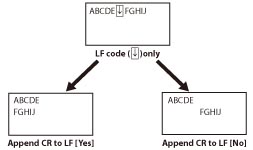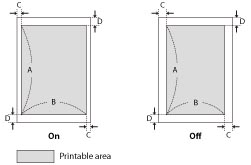[PCL] Settings
NOTE |
These settings are applicable only when printing in the PCL mode. |
[Paper Save]
[On], [Off]*
This setting specifies whether to output a blank page when there is no data to print on the page.
[On]
A blank page is not output, thus saving paper.
[Off]
A blank page is output.
NOTE |
Depending on the content of print data, some pages may not be determined as blank even if nothing is drawn on the print area of those pages. |
[Orientation]
[Portrait]*, [Landscape]
This setting enables you to set the paper orientation.
[Portrait]
The print image is printed in portrait orientation regardless of the orientation of the paper in the paper drawers.

[Landscape]
The print image is printed in landscape orientation regardless of the orientation of the paper in the paper drawers.

[Font Source]
[Internal]*, [Soft/External]
You can set the font source. [Soft/External] is displayed only when soft font or External font is installed.
[Font Number]
0 to 104; 0* (If the [Font Source] setting is [Internal].)
1 to 999; 1* (If the [Font Source] setting is [Soft/External].)
1 to 999; 1* (If the [Font Source] setting is [Soft/External].)
You can set the default font typeface for this printer function using the corresponding font numbers. Valid font numbers are from 0 to 104 if the [Font Source] setting is [Internal]. If the [Font Source] setting is [Soft/External], the maximum range of the value is from 1 to 999 and the available range is affected by the amount of external fonts installed.
[Point Size]
4.00 to 999.75 point (in increments of 0.25 points); 12.00* point
If the number selected in [Font Number] is that of a proportionally spaced scalable font, this option appears in the PCL menu. It enables you to specify a point size for the default font. The point size can be adjusted in increments of 0.25 points.
NOTE |
This mode is available if a value from '1' to '78' is specified for [Font Number]. |
[Pitch]
0.44 to 99.99 cpi (in increments of 0.01 cpi); 10.00* cpi
If the number selected in [Font Number] is that of a fixed pitch scalable font, [Pitch] appears in the PCL menu. It enables you to specify the pitch for the default font. The pitch can be adjusted in increments of 0.01 cpi (characters per inch).
NOTE |
This mode is available if a value of '0' or from '79' to '104' is specified for [Font Number]. |
[Form Lines]
5 to 128 lines; 64* lines
This setting enables you to specify the number of lines to be printed on a page. You can specify from 5 to 128 lines.
[Character Code] (Symbol Set)
[ARABIC8], [DESKTOP], [GREEK8], [HEBREW7], [HEBREW8], [ISO4], [ISO6], [ISO11], [ISO15], [ISO17], [ISO21], [ISO60], [ISO69], [ISOCYR], [ISOGRK], [ISOHEB], [ISOL1], [ISOL2], [ISOL5], [ISOL6], [ISOL9], [LEGAL], [MATH8], [MCTEXT], [MSPUBL], [PC8]*, [PC8DN], [PC8GRK], [PC8TK], [PC775], [PC850], [PC851], [PC852], [PC858], [PC862], [PC864], [PC866], [PC1004], [PIFONT], [PSMATH], [PSTEXT], [ROMAN8], [ROMAN9], [VNINTL], [VNMATH], [VNUS], [WIN30], [WINBALT], [WINL1], [WINL2], [WINL5], [WINGRK], [WINCYR], [WINARB]
This setting enables you to select the symbol set most suited to the needs of the host computer.
[Custom Paper]
[On], [Off]*
This setting enables you to specify a custom paper size. If you select [On], you can enter a custom size.
You can only select the custom paper size entered with settings from the printer driver.
[Unit of Measure]
[Millimeters]*, [Inches]
This setting enables you to specify the unit of measurement you would like to use to specify your custom paper size.
[X dimension]
For information on the setting values displayed, see "User's Guide."
This setting enables you to specify the X dimension of the custom paper. The X dimension can be adjusted in increments of 0.1 mm.
This mode can be very useful when part of the printed image is cut off. Increasing this dimension may allow some of the missing text to be correctly printed. Make sure you do not increase the X dimension beyond the actual size of the paper you are using for printing.
[Y dimension]
For information on the setting values displayed, see "User's Guide."
This setting enables you to specify the Y dimension of the custom paper. The Y dimension can be adjusted in increments of 0.1 mm.
This mode can be very useful when part of the printed image is cut off. Increasing this dimension may allow some of the missing text to be correctly printed. Make sure you do not increase the Y dimension beyond the actual size of the paper you are using for printing.
[Append CR to LF]
[Yes], [No]*
This setting enables you to specify whether to append a carriage return (CR) when line feed code (LF) is received.
[Yes]
The print head moves to the beginning of the next line when line feed code is received.
[No]
The print head moves down to the next line when line feed code is received, and the margin does not change (such as to the beginning of the next line).

[Enlarge A4 Print Width]
[On], [Off]*
This setting determines whether to expand the printable area of A4 size paper to that of Letter size in width.
[On]
All the area on a page 1/8" (4.2 mm) from the top and bottom edges and 1/8" (3.4 mm) from the left and right edges is available for printing on A4 paper. Only the width increases.
[Off]
All the area on a page 1/8" (4.2 mm) from the top, bottom, left, and right edges is available for printing on A4 paper.

Settings | On | Off |
A: Length | 11 3/8" (287.9 mm) | |
B: Width | 8" (203.2 mm) | 8" (201.5 mm) |
C: Left and right edges | 1/8" (3.4 mm) | 1/8" (4.2 mm) |
D: Top and bottom edges | 1/8" (4.2 mm) | |
NOTE |
This setting is applicable for A4 paper only. This setting is applicable for portrait orientation only. |
[Halftones]
[Text]: [Color Tone], [Resolution]*, [Gradation], [High Resolution]
[Graphics]: [Color Tone]*, [Resolution], [Gradation], [High Resolution]
[Image]: [Color Tone]*, [Resolution], [Gradation], [High Resolution]
This setting specifies how to express halftones.
Settings can be applied separately for text, graphics, and image data.
Settings can be applied separately for text, graphics, and image data.
[Color Tone]
You can print with sharp gradation and well-balanced texture, contrasting light and shade, which is best for printing images.
[Resolution]
A dither pattern that gives priority to the resolution of the images is used. This helps eliminate the appearance of jagged or uneven lines along the edges of objects and is best for printing standard text and graphics.
[Gradation]
A dither pattern that gives priority to the appearance of smooth changes in tone is used. This is best for reproducing images with delicate gradations or changes of tone.
[High Resolution]
Finer printing can be done than with [Resolution], although toner stability is somewhat weaker. This is suited to printing small characters and fine lines, and outlines (such as from CAD data) sharply.
[Halftones] (6800 / 6000 / 4900 / 4800 Series)
[Text]: [Resolution]*, [Gradation], [Error Diffusion]
[Graphics]: [Resolution], [Gradation]*, [Error Diffusion]
[Image]: [Resolution], [Gradation]*, [Error Diffusion]
This setting specifies how to express halftones.
Settings can be applied separately for text, graphics, and image data.
Settings can be applied separately for text, graphics, and image data.
[Resolution]
A dither pattern that gives priority to the resolution of the images is used. This helps eliminate the appearance of jagged or uneven lines along the edges of objects and is best for printing standard text and graphics.
[Gradation]
A dither pattern that gives priority to the appearance of smooth changes in tone is used. This is best for reproducing images with delicate gradations or changes of tone.
[Error Diffusion]
This mode is suitable for printing data with text and thin lines and the curved lines of CAD data, etc.
NOTE |
The stability of the texture and fixed toner may be reduced when this mode is used. |